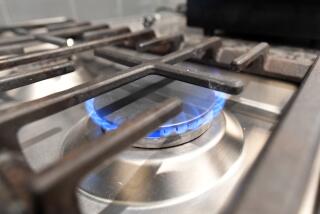INSIDE & OUT : A Too-Hot Time in the Old Stove
- Share via
Q: The last time I used my 10-year-old gas oven, I turned it to 350 degrees, but the temperature climbed way past that mark. I assume there’s a problem in the thermostat. Would that be hard for me to replace?
R.W.
Santa Ana
*
A: If you’re reasonably handy, you shouldn’t have a problem replacing the thermostat, says Tom Houlihan of Orange County Appliance Parts in Garden Grove. It’s attached to the knob shaft, so if you’re able to pull the knob off and remove the stove top, you should be able to get access to it.
After you get it out of the oven, take it to a parts store, where they can try to match one up for you, because there are so many different models available.
*
Q: One of my pet peeves when painting is that after the hinges are painted, they tend to chip very quickly and the hinge pins tend to rise up. How can I keep the hinges covered and the pins down?
G.G.
Brea
*
A: Because hinges have moving parts and metal works against metal when the door opens, it’s hard to keep them covered, says painter David Olsen of Fountain Valley.
The key is to not glob on the paint. Use light, thin coats at least three times and let the hinge dry completely before using it.
People will often notice their hinge pins rise after they’ve used a lubricant to stop a door from squeaking. Just push them down periodically with your hand; tapping them with a hammer could bend them.
*
Q: We’re considering having some remodeling work done on our house, which has plaster walls. We’d like to add two rooms. I’m wondering, however, if we should install standard drywall or have the walls plastered. What’s best?
M.O.
Tustin
*
A: Plaster walls are becoming a classic because most homes are built with less-expensive drywall, says Pete Gorman of Rancho Lumber in Westminster. Many people appreciate their softer look, with corners that aren’t quite as sharp as you’d find with drywall.
However, plaster is less flexible, which isn’t a good quality to have in Southern California. Earthquakes tend to cause cracking, and the plaster often seems to be in need of constant repair. You can have the rooms built out with drywall, then coat it with plaster.
*
Q: Our one-piece vinyl floor is 8 years old but still in good condition. My only complaint is that it has a couple of deep scratches where the refrigerator had been pulled out. Any ideas on how to repair them?
K.H.
San Juan Capistrano
*
A: You have two alternatives, says floor installer Mike Graves of Fullerton. You can use a clear epoxy glue and spread it in the scratches. When it dries, it will help bond the floor surface and hopefully keep the scratches from getting bigger. It doesn’t, however, help the floor look any better.
With any luck, you still might have some remnant of the floor left over from the installation. If the remnant is in good condition, you can remove a square of the damaged floor and replace it with a matching piece.
*
Q: We bought a home that was painted a couple of years ago. The paint is still in great shape except on the aluminum gutters. It appears that a semi-gloss enamel was used and it’s flaking off in a number of spots. How should this be repainted so the paint sticks?
W.T.
Anaheim
*
A: You’ll first need to remove all of the loose paint with a wire brush and sandpaper, says Jim Grant of Dutch Boy Home Decorating Center in Santa Ana. Many times paint won’t stick to galvanized metal because it hasn’t been etched. You may need to use an acid and water mixture to etch it, or use sandpaper. After that’s been done, use an acrylic primer and then your acrylic finish coat.
*
If you have a question about your home or garden, A Helping Hand will help you find the answer. Send questions to: John Morell, Home Design, The Times Orange County, 1375 Sunflower Ave., Costa Mesa, CA 92626.


